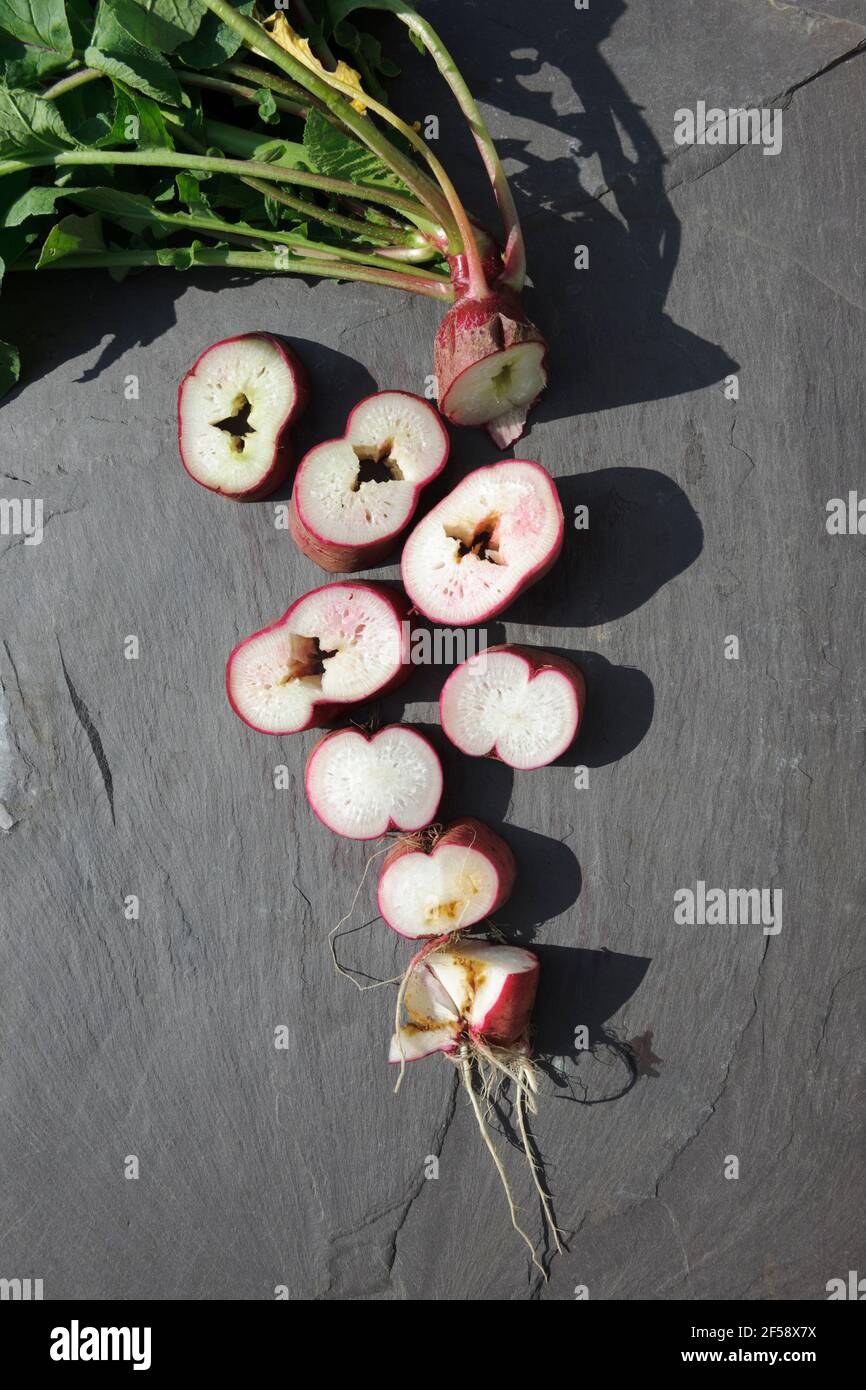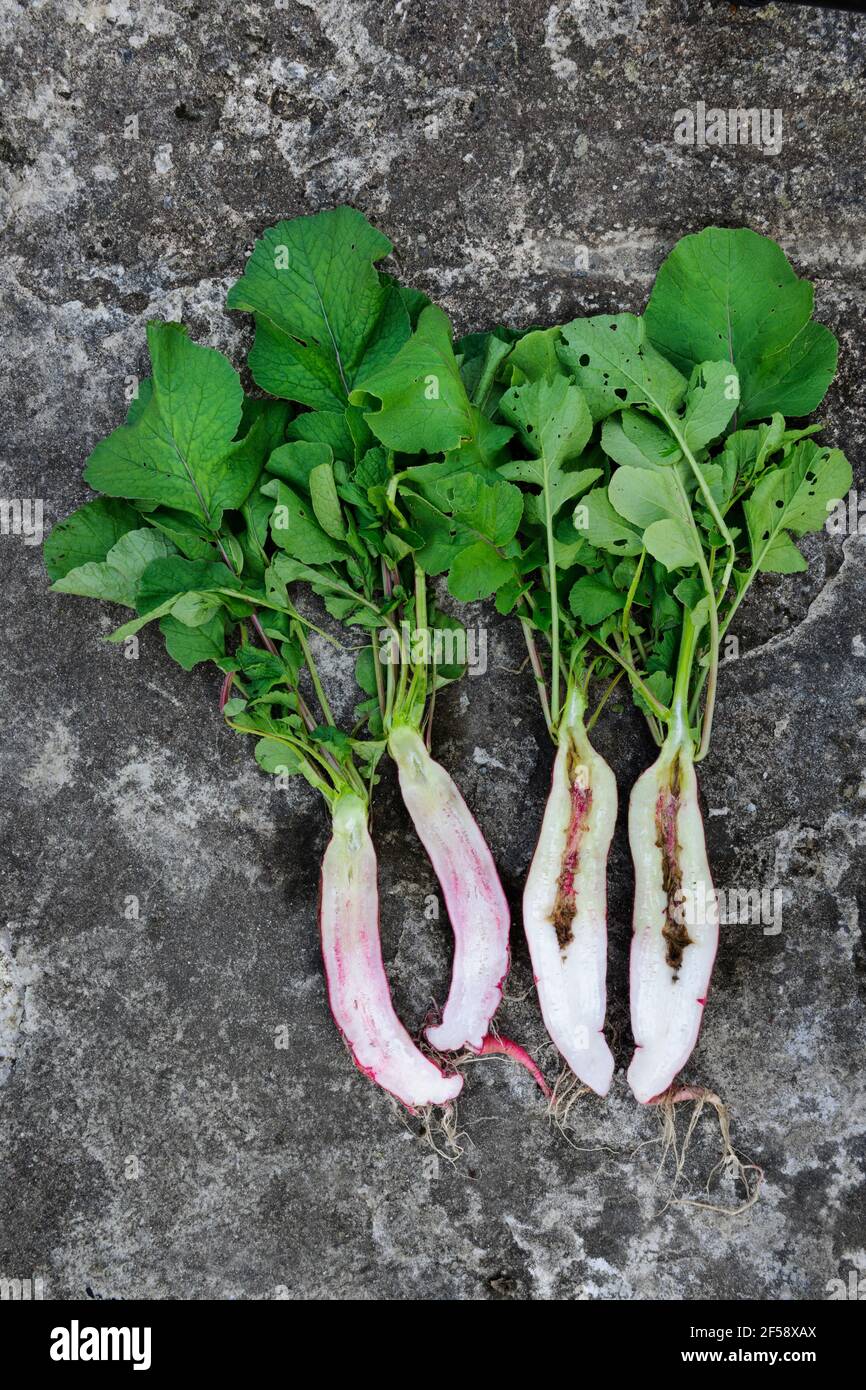Radishes are hollow due to inconsistent watering or rapid growth. These factors cause internal tissue development issues.
Radishes are a popular root vegetable known for their crisp texture and peppery flavor. Gardeners often face the issue of hollow radishes, which compromises their quality. Ensuring even and consistent watering helps prevent this problem. Rapid growth, another common cause, can be managed by providing optimal growing conditions.
Choosing the right variety and maintaining balanced soil moisture are crucial steps. Regularly monitoring soil and plant health can make a significant difference. By understanding these factors, gardeners can cultivate healthy, solid radishes and enjoy a bountiful harvest. Proper care leads to better, more satisfying results in your vegetable garden.
Introduction To Hollow Radishes
Radishes sometimes have a strange problem. They become hollow inside. This can puzzle many gardeners. Understanding why this happens can help. Let’s explore the reasons behind hollow radishes.
Curious Phenomenon
Seeing a radish with a hollow center is odd. It looks like it should be solid. This phenomenon happens due to rapid growth. When radishes grow too fast, they can’t fill in the center.
Weather plays a big role. Hot weather causes radishes to grow quickly. This rapid growth leads to hollow centers. Another reason is irregular watering. Plants need consistent water. Too much or too little can cause problems.
Common Misconceptions
Some believe hollow radishes mean poor soil. This is not always true. Soil quality is important but not the only factor. Others think pests cause hollow radishes. While pests can harm radishes, they don’t make them hollow.
Understanding these common misconceptions helps better gardening. Knowing the real reasons helps solve the problem.
| Cause | Description |
|---|---|
| Rapid Growth | Fast growth leads to hollow centers. |
| Hot Weather | High temperatures speed up growth. |
| Irregular Watering | Inconsistent water affects growth. |

Credit: www.alamy.com
Anatomy Of A Radish
The radish is a root vegetable known for its crisp texture and peppery flavor. Understanding the Anatomy of a Radish can help explain why some radishes are hollow. Let’s dive into the structure, growth, and nutritional profile of this interesting vegetable.
Structure And Growth
Radishes grow underground, developing a bulbous root. The outer layer is usually red or white. This skin protects the inner flesh. Inside, the radish flesh is typically white and firm. The hollow center can develop due to rapid growth or inconsistent watering.
Radishes need consistent moisture for even growth. If they grow too fast, the center can form a cavity. This hollow center often occurs in hot weather. Proper care and watering can prevent this issue.
Nutritional Profile
Radishes are low in calories but rich in nutrients. They provide vitamin C, potassium, and fiber. Eating radishes can boost your immune system. They also help in digestion and hydration.
| Nutrient | Amount per 100g |
|---|---|
| Calories | 16 |
| Vitamin C | 14.8 mg |
| Potassium | 233 mg |
| Fiber | 1.6 g |
Radishes also contain antioxidants. These help fight free radicals in your body. Including radishes in your diet can provide numerous health benefits.
Environmental Factors
Understanding why radishes become hollow can help gardeners grow better crops. Environmental factors play a huge role in this issue. Let’s explore two major factors: soil conditions and watering practices.
Soil Conditions
Soil quality is crucial for radish growth. Radishes prefer loamy soil. This type of soil is rich in nutrients and drains well. Poor soil can lead to hollow radishes. Ensure the soil is not too sandy or clay-heavy.
Soil pH also affects radish health. Radishes grow best in soil with a pH of 6.0 to 7.0. Use a pH meter to check your soil. Adjust the pH if needed with lime or sulfur.
Nutrient levels are important too. Radishes need enough nitrogen, phosphorus, and potassium. Use a balanced fertilizer to meet these needs. Over-fertilizing can harm radishes. Follow the instructions on the fertilizer package.
Watering Practices
Proper watering is essential for healthy radishes. Radishes need consistent moisture. Irregular watering can cause hollow roots. Water the plants evenly and regularly.
Over-watering can also be a problem. Too much water can lead to root rot and hollow radishes. Make sure the soil drains well to avoid waterlogging.
Watering schedule should be adjusted based on weather. During hot weather, radishes need more water. In cooler weather, reduce the watering frequency. Use a soaker hose or drip irrigation for best results.
| Factor | Ideal Condition |
|---|---|
| Soil Type | Loamy |
| Soil pH | 6.0 – 7.0 |
| Watering Frequency | Consistent |
| Drainage | Well-Drained |
By paying attention to these environmental factors, you can grow healthy, full radishes.
Impact Of Weather
Weather plays a significant role in the development of radishes. It can cause radishes to become hollow. Let’s explore the specific weather conditions that impact radishes.
Temperature Fluctuations
Radishes thrive in consistent temperatures. Sudden temperature changes can stress them. This stress can lead to hollow centers.
Here’s how it happens:
- High temperatures cause rapid growth.
- Low temperatures slow down growth.
- This inconsistency creates gaps inside the radish.
Maintaining a steady temperature helps radishes grow solid and healthy.
Seasonal Changes
Radishes are sensitive to different seasons. Spring and fall are ideal for their growth. Summer and winter can pose challenges.
In spring and fall:
- Temperatures are moderate.
- Growth is steady.
- Radishes remain firm.
In summer and winter:
- Temperatures can be extreme.
- Growth is uneven.
- This can cause hollow centers.
Planting radishes in the right season ensures better results.
Genetic Influences
Radishes can sometimes become hollow, and genetics play a big role. Understanding genetic influences helps us see why some radishes turn out this way. Let’s dive into the genetic factors affecting radishes.
Varietal Differences
Different radish varieties show different traits. Some varieties are more prone to hollowness. This can be due to their genetic makeup.
Here is a table showing some radish varieties and their susceptibility to hollowness:
| Radish Variety | Susceptibility to Hollowness |
|---|---|
| Cherry Belle | Low |
| French Breakfast | Medium |
| Daikon | High |
Inherited Traits
Radishes inherit traits from their parent plants. If parent plants are hollow, offspring may be too. This is called genetic inheritance.
Here are some inherited traits that affect radish hollowness:
- Root size
- Growth speed
- Resistance to pests
Understanding these traits helps in selecting the right seeds. Choosing the right variety can reduce the chances of hollow radishes.

Credit: www.reddit.com
Agricultural Practices
Understanding why radishes become hollow requires looking at specific agricultural practices. These practices play a crucial role in the quality of radishes. Proper techniques ensure they grow healthy and solid.
Planting Techniques
Planting techniques significantly affect radish quality. Proper spacing between seeds is crucial. Overcrowded radishes compete for nutrients. This competition can cause hollow centers. Ensure adequate soil depth for root growth. Shallow soil limits the radish’s growth, leading to hollow roots. Consistent watering is another key practice. Irregular watering patterns stress the plants. This stress can result in hollow radishes.
Harvest Timing
Harvest timing is critical for radish quality. Harvest radishes promptly. Leaving them in the ground too long causes them to become hollow. Radishes mature quickly, usually within 25-30 days. Check them regularly to harvest at the right time. Over-mature radishes are more likely to have hollow centers. Cool temperatures are best for harvesting. Warm temperatures speed up maturity, increasing the risk of hollowness.
Pest And Disease Factors
Radishes may become hollow due to several pest and disease factors. These elements significantly affect the quality and growth of radishes. Addressing these issues can help produce healthy, solid radishes.
Common Pests
Several pests can cause radishes to become hollow. Below are some of the most common ones:
- Root Maggots: These pests lay eggs in the soil. The larvae then burrow into the radish roots, creating tunnels.
- Aphids: Aphids suck sap from the leaves. This weakens the plant and leads to poor root development.
- Flea Beetles: Flea beetles chew small holes in the leaves. This damage can stress the plant and affect root growth.
Disease Prevention
Preventing diseases can help maintain the health of your radishes. Here are some effective strategies:
- Crop Rotation: Rotate crops to prevent soil-borne diseases. Plant radishes in different spots each year.
- Proper Spacing: Space plants adequately to improve air circulation. This reduces the risk of fungal infections.
- Water Management: Water radishes at the base. Avoid overhead watering to reduce leaf wetness, which can lead to diseases.
- Soil Health: Use well-draining soil to avoid root rot. Healthy soil promotes strong, solid radish roots.
| Factor | Effect | Solution |
|---|---|---|
| Root Maggots | Hollow roots | Use row covers to protect plants |
| Aphids | Weak plants | Introduce natural predators like ladybugs |
| Flea Beetles | Leaf damage | Apply neem oil as a deterrent |

Credit: www.alamy.com
Preventing Hollow Radishes
Hollow radishes can be disappointing for gardeners. They look healthy outside but have empty centers. Understanding how to prevent this issue ensures a bountiful harvest. Follow the best practices and expert tips below.
Best Practices
- Water Consistently: Radishes need regular watering. Keep the soil moist but not waterlogged.
- Proper Spacing: Space radish seeds at least 1 inch apart. This prevents overcrowding.
- Soil Quality: Use well-drained, loose soil. Avoid compacted or heavy clay soils.
- Harvest Timely: Pick radishes when they are young. Overgrown radishes often turn hollow.
Expert Tips
- Soil Testing: Test your soil before planting. Ensure it has balanced nutrients.
- Mulching: Use mulch to retain soil moisture. It also keeps the soil cool.
- Temperature Control: Radishes grow best in cool temperatures. Plant them in early spring or fall.
- Fertilization: Use a balanced fertilizer. Avoid too much nitrogen, as it promotes leaf growth over root development.
Following these best practices and expert tips will help you grow healthy radishes. Avoid hollow centers and enjoy a crunchy, flavorful harvest.
| Best Practices | Expert Tips |
|---|---|
| Water Consistently | Soil Testing |
| Proper Spacing | Mulching |
| Soil Quality | Temperature Control |
| Harvest Timely | Fertilization |
Frequently Asked Questions
What Causes Radishes To Be Hollow?
Radishes become hollow due to rapid growth and inconsistent watering. When they grow too quickly, the internal tissues can’t keep up, leading to hollow centers.
How Can I Prevent Hollow Radishes?
To prevent hollow radishes, ensure consistent watering and avoid excessive fertilization. Slow, steady growth is key to maintaining solid, healthy radishes.
Are Hollow Radishes Safe To Eat?
Yes, hollow radishes are safe to eat. They might be less flavorful and slightly woody, but they are still edible.
Does Soil Type Affect Radish Hollowness?
Yes, soil type can affect radish hollowness. Well-draining, loose soil helps radishes grow evenly, reducing the risk of hollow centers.
Conclusion
Understanding why radishes become hollow helps gardeners and consumers alike. Proper watering and soil conditions are crucial. Ensure consistent moisture and avoid overcrowding. By following these tips, you can enjoy crunchy, flavorful radishes. Happy gardening, and may your radishes always be full and delicious!
